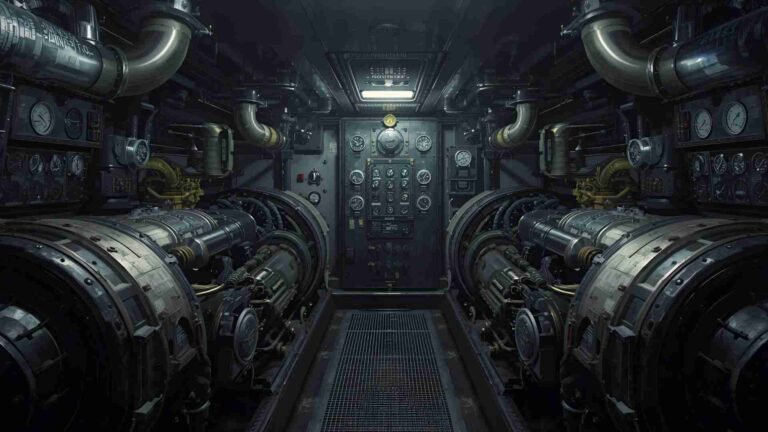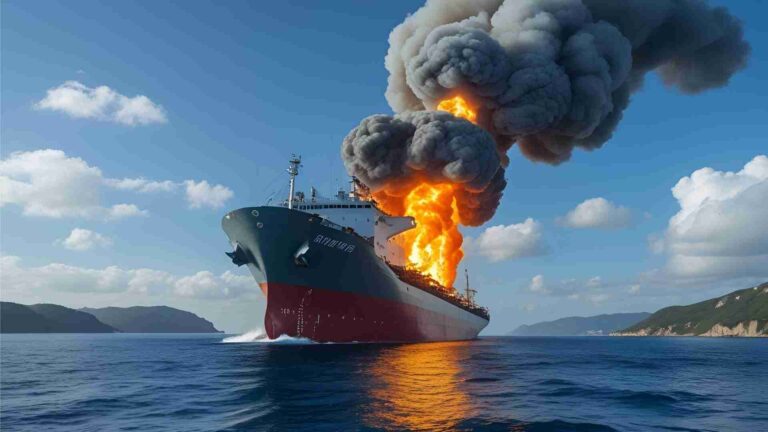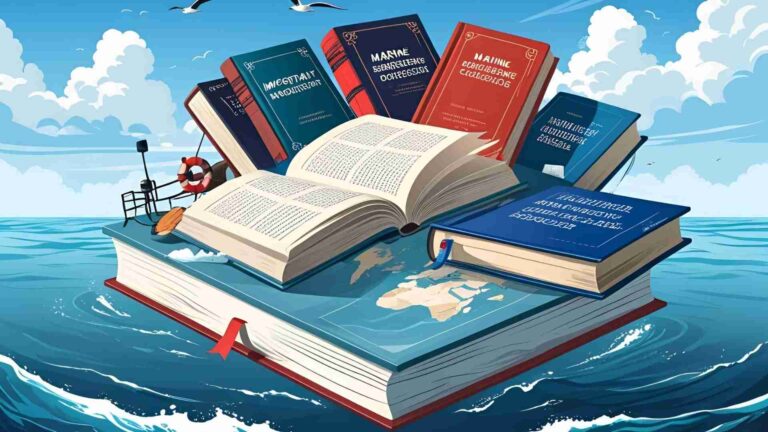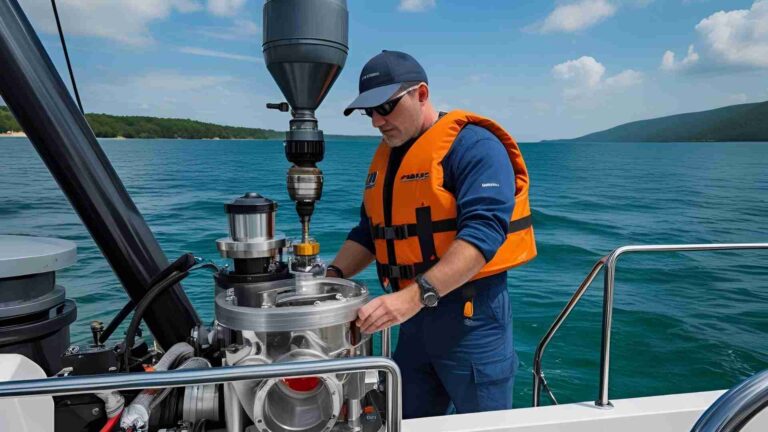International Code of Safety for Ship Using Gases or Other Low-flashpoint Fuels (IGF Code)
Learn about the IGF Code, IMO’s safety standard for ships using LNG and low-flashpoint fuels, ensuring safe design and operations.
The maritime industry is undergoing a transformative shift toward cleaner and more sustainable fuel alternatives, driven by global demands for reduced emissions and environmental responsibility. The International Code of Safety for Ships Using Gases or Other Low-Flashpoint Fuels (IGF Code), established by the International Maritime Organization (IMO), plays a pivotal role in this transition. This code sets stringent safety standards for ships using fuels with a flashpoint below 60°C, such as liquefied natural gas (LNG) and methanol, ensuring the safety of vessels, crews, and the environment. This article provides an in-depth exploration of the IGF Code, its purpose, key provisions, design considerations, operational requirements, and training mandates, alongside its impact on the maritime industry.
What is the IGF Code?
The IGF Code is an international standard developed by the IMO to regulate the safe use of gases and low-flashpoint fuels in maritime transport. Unlike the International Code for the Carriage of Liquefied Gases in Bulk (IGC Code), which applies to gas carriers, the IGF Code focuses on ships using these fuels for propulsion and auxiliary purposes. Its primary objective is to minimize risks to ships, their crews, and the marine environment by providing mandatory criteria for the design, construction, and operation of vessels using low-flashpoint fuels.
The code adopts a goal-based approach, specifying objectives and functional requirements for each section to ensure safety, reliability, and dependability equivalent to conventional oil-fueled systems. It addresses the unique challenges posed by fuels like LNG, which, while environmentally beneficial, require specialized handling due to their volatility.
Key Objectives of the IGF Code
- Ensure safety in the design and operation of ships using low-flashpoint fuels.
- Minimize risks to crew, vessels, and the environment.
- Provide a standardized framework for the maritime industry’s transition to cleaner fuels.
- Incorporate evolving technology and operational experience through periodic reviews.
Why the IGF Code Matters
The maritime sector is a significant contributor to global emissions, prompting a shift toward cleaner fuels like LNG, which emits lower levels of sulfur oxides, nitrogen oxides, and particulates compared to traditional heavy fuel oil. However, these fuels introduce safety challenges, such as the risk of leaks, explosions, or fires due to their low flashpoints. The IGF Code addresses these challenges by establishing a robust safety framework, enabling the industry to adopt sustainable fuels without compromising safety.
The code’s adoption has been instrumental in supporting the IMO’s broader environmental goals, including the Initial IMO Strategy on Reduction of GHG Emissions from Ships, which aims for a 50% reduction in greenhouse gas emissions by 2050. By providing clear guidelines, the IGF Code facilitates the safe integration of alternative fuels into maritime operations, fostering innovation and sustainability.
Core Components of the IGF Code
The IGF Code is comprehensive, covering all aspects of ship design, equipment, and operations that require special consideration for low-flashpoint fuels. Below are the key areas addressed by the code:
1. Design Considerations
The IGF Code outlines specific design requirements to ensure the safe handling and storage of low-flashpoint fuels. These include:
- Fuel Containment Systems: Tanks must be designed to withstand the pressures and temperatures associated with gases like LNG. This includes double-walled tanks and insulation to prevent leaks or thermal damage.
- Pressure Relief Systems: To manage overpressure risks, vessels must be equipped with safety valves and venting systems.
- Ventilation: Adequate ventilation is required in fuel storage and handling areas to prevent the accumulation of flammable gases.
- Fuel Piping: Piping systems must be designed to prevent leaks and withstand the corrosive properties of certain fuels.
- Explosion Prevention: Measures such as gas detection systems and explosion-proof equipment are mandated to mitigate risks.
2. Regulations for Machinery and Spaces
The IGF Code specifies regulations for machinery spaces and other areas where low-flashpoint fuels are used or stored:
- ESD-Protected Machinery Spaces: Emergency shutdown (ESD) systems are required to isolate fuel systems in case of emergencies.
- Fire Safety and Protection: Enhanced fire detection and suppression systems are mandated to address the unique fire risks of low-flashpoint fuels.
- Engine Design: Engines, such as marine LNG engines, must meet specific standards for efficiency and safety.
- Bilge Systems and Drip Trays: These systems prevent the accumulation of fuel residues, reducing the risk of fires or environmental contamination.
- Airlocks and Entrances: Enclosed spaces must have controlled access to prevent gas ingress.
3. Operational Procedures
The IGF Code includes detailed operational guidelines to ensure safe handling of low-flashpoint fuels:
- Bunkering: Procedures for safely transferring fuel from bunkering vessels to ships, including leak detection and emergency protocols.
- Maintenance: Regular inspections and maintenance of fuel systems to ensure operational integrity.
- Drills and Emergency Exercises: Crews must conduct regular training exercises to prepare for emergencies such as fuel leaks or fires.
- Inerting and Purging: Processes to remove flammable gases from tanks and systems to prevent explosions.
- Atmospheric Control: Monitoring and controlling the atmosphere within fuel containment systems to maintain safety.
4. Training Requirements
The safe operation of ships using low-flashpoint fuels requires specialized training for seafarers. The IGF Code, in conjunction with amendments to the International Convention on Standards of Training, Certification and Watchkeeping for Seafarers (STCW), mandates:
- Basic Training: All crew members involved in fuel handling or emergency response must complete basic training as per STCW Regulation V/3, paragraph 5. This includes understanding fuel properties, safety protocols, and emergency procedures.
- Advanced Training: Masters, engineering officers, and personnel with direct responsibility for fuel systems must complete advanced training as per STCW Regulation V/3, paragraph 7. This covers in-depth knowledge of fuel systems, risk management, and operational procedures.
- Exemptions: Smaller vessels (typically under 500 gross tonnage, except passenger ships) may be exempt from certain training requirements if deemed impractical, provided safety is not compromised.
The following table summarizes the training requirements:
| Training Level | Target Audience | Key Requirements | STCW Reference |
|---|---|---|---|
| Basic Training | Crew with safety duties | Knowledge of fuel properties, safety protocols, emergency response | Regulation V/3, paragraph 5; Table A-V/3-1 |
| Advanced Training | Masters, engineering officers, key personnel | In-depth fuel system management, risk assessment, operational procedures | Regulation V/3, paragraph 7; Table A-V/3-2 |
| Exemptions | Crew on small vessels | Limited exemptions for vessels under 500 GT, subject to safety considerations | Regulation V/3, paragraph 8 |
Integration with SOLAS
The IGF Code is enforced through amendments to the International Convention for the Safety of Life at Sea (SOLAS), which mandates compliance for new ships using low-flashpoint fuels. Key SOLAS amendments include:
- Chapter II-1, Part F: Provides a methodology for alternative design and arrangements for machinery, electrical installations, and fuel storage systems.
- Chapter II-1, Part G: Requires ships constructed after January 1, 2017, to comply with the IGF Code.
- Chapter II-2: Enhances fire safety and venting provisions to address the risks of low-flashpoint fuels.
These amendments ensure that the IGF Code’s provisions are integrated into the broader maritime safety framework, providing a cohesive approach to regulating alternative fuels.
Environmental and Safety Benefits
The adoption of low-flashpoint fuels like LNG offers significant environmental benefits. These fuels produce:
- Lower Sulfur Oxides (SOx): Near-zero emissions, aligning with IMO’s sulfur cap regulations.
- Reduced Nitrogen Oxides (NOx): Lower emissions compared to conventional fuels.
- Minimal Particulate Matter: Cleaner combustion reduces air pollution.
However, the safety challenges of these fuels necessitate the IGF Code’s stringent regulations. By addressing risks such as leaks, fires, and explosions, the code ensures that the environmental advantages of alternative fuels are realized without compromising safety.
Implementation and Global Adoption
The IGF Code is mandatory for ships flying the flags of IMO member states. For example, countries like Canada have incorporated the code into their national regulations, requiring compliance for vessels using low-flashpoint fuels. The code’s global adoption ensures consistency in safety standards, facilitating international trade and maritime operations.
The IMO periodically reviews the IGF Code to incorporate advancements in fuel technology and operational experience. This adaptability ensures that the code remains relevant as new fuels, such as hydrogen or ammonia, emerge in the maritime sector.
Chart: IGF Code Structure
The following chart illustrates the key components of the IGF Code and their interconnections:
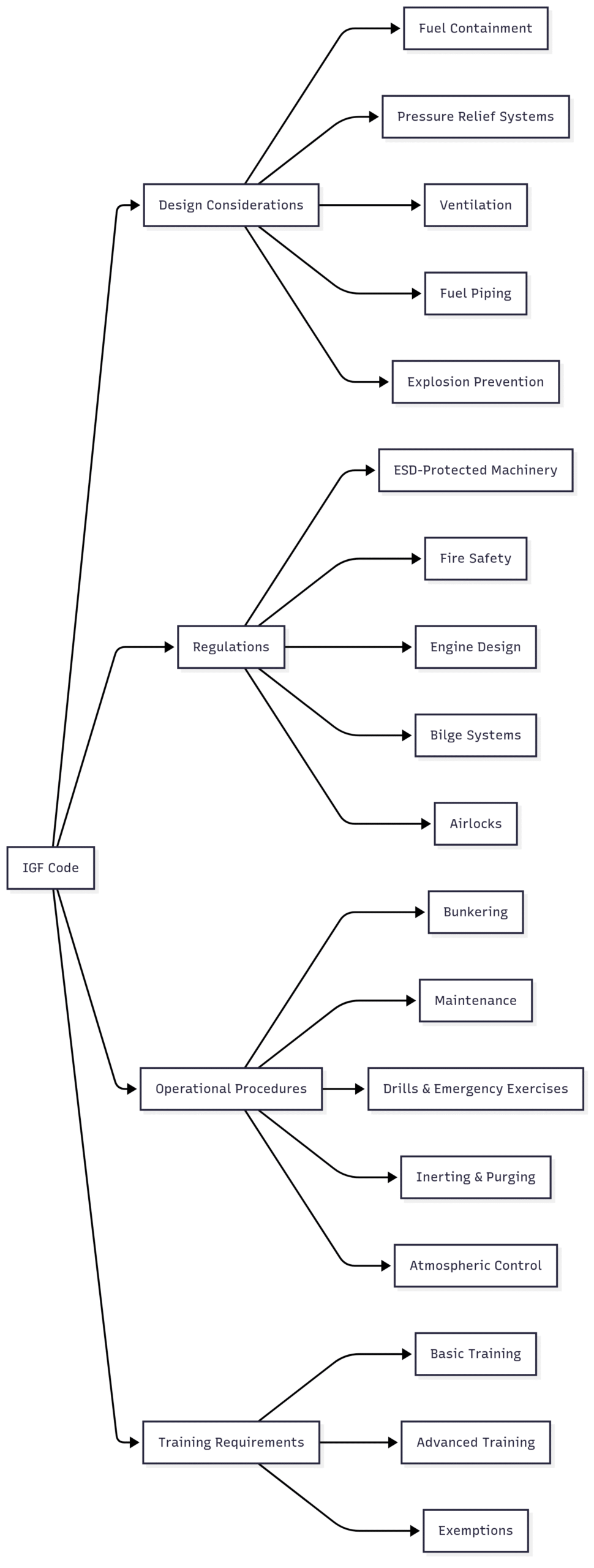
This chart highlights the interconnected nature of the IGF Code’s provisions, ensuring comprehensive coverage of safety aspects.
Challenges and Future Outlook
While the IGF Code has been instrumental in enabling the safe use of low-flashpoint fuels, challenges remain:
- Technological Evolution: Rapid advancements in fuel technology require continuous updates to the code.
- Training Accessibility: Ensuring seafarers worldwide have access to certified training programs can be logistically challenging.
- Cost Implications: Retrofitting existing ships or building new ones to comply with the IGF Code can be costly, though no specific pricing data is available.
Looking ahead, the IGF Code will likely expand to cover emerging fuels like hydrogen and ammonia, which are gaining traction as zero-carbon alternatives. The IMO’s commitment to periodic reviews ensures that the code will evolve to meet future needs, supporting the maritime industry’s transition to a sustainable future.
Conclusion
The International Code of Safety for Ships Using Gases or Other Low-Flashpoint Fuels (IGF Code) is a cornerstone of the maritime industry’s shift toward cleaner and safer fuel alternatives. By providing a robust framework for ship design, equipment, operations, and training, the code ensures that the adoption of low-flashpoint fuels like LNG does not compromise safety. Its integration with SOLAS and STCW conventions underscores its importance in global maritime regulations, while its goal-based approach allows flexibility for future innovations. As the industry continues to embrace sustainable fuels, the IGF Code will remain a critical tool in balancing environmental benefits with operational safety.
Happy Boating!
Share International Code of Safety for Ship Using Gases or Other Low-flashpoint Fuels (IGF Code) with your friends and leave a comment below with your thoughts.
Read How Emergency Bilge Suction Valves Work until we meet in the next article.

